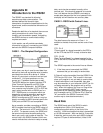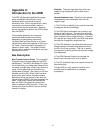
43
Appendix B:
Introduction to the RS232
The 'RS232' is a standard for bit serial
asynchronous data communication. The
standard defines the format for data
transmission, the electrical specifications for the
signal levels, and the mechanical dimensions of
connectors.
Despite the definition of a standard, there are so
many permutations of control lines, data
formats, and transmission speeds, that getting
two RS232 devices to communicate usually
requires some work.
In this section, we will provide some basic
information to aid you in connecting your RS232
device to the SR530 Computer Interface.
CASE 1 - The Simplest Configuration.
In this case, one wire is used to send data from
device A to device B and another wire is used to
send data from device B to device A. Notice
that pin 2 is an output on device A and an input
on device B. (It is good practice to run the
ground, pin 7, between the devices as well).
The RS232 defines two types of devices; DTE
(Data Terminal Equipment) and DCE (Data
Communications Equipment.) An RS232 port
on a computer may be either a DTE or DCE but
nearly every terminal with an RS232 port is a
DTE. RS232 ports on a computer which are
intended to connect to a modem, such as the
COM1: port on the IBM PC, are DTE. The
SR530 is configured as DCE, and so it may be
directly connected to ASCII terminals and to the
COM: ports on IBM PC's and compatibles.
As an example, consider connecting an RS232
ASCII computer terminal to the SR530 using a 2
wire link. The terminal is a DTE and the SR530
is a DCE. To operate correctly, the SR530 and
the terminal must have the same settings for
baud rate, parity, and number of stop bits. The
control lines in the RS232 Standard, which are
used to indicate that a device is ready to accept
data, must also be connected correctly at the
terminal end. If the terminal responds to a control
line, it will believe that the SR530 is not ready to
accept data (because the line is not passed in this
example) and will therefore not send any data.
CASE 2 - RS232 with Control Lines.
The data lines are the same as in Case 1. In
addition to the data lines, there are two control lines
used:
CTS - Pin 5
"Clear to send" is a signal asserted by the DCE to
tell the DTE that the DCE is ready to receive data.
DTR - Pin 20
"Data Terminal Ready" is a signal asserted by the
DTE to tell the DCE that the DTE is ready to receive
data.
The SR530 responds to the control lines as follows:
1) If the lines are not connected, the SR530
assumes that you are ready to receive data.
2) Data will not be transmitted from the SR530 if the
DTR line (pin 20) is low. This is useful in the case
when your program is not yet ready to receive data.
If data transmission is not suspended, then data
may be overwritten in your computer's UART (as it is
not being retrieved by the program and so will be
lost.) When this happens, the 'over-run' flag will be
set in your computer's UART and it may be
recognized by the operating system, generating an
error message such as "I/O Device Error" (See the
"W" command in the SR530 Command List for
another way to slow data transmission.)
Baud Rate
The RS232 baud rate of the SR530 is switch
selectable from 300 to 19.2K baud (see
configuration switch setting in the front of this
manual.) 19.2K baud means that data is transmitted
at 19,200 bits/second. With one start bit, 2 stop bits,
8 data bits, and no parity bits, each ASCII character
requires 573 µsec to be transmitted (11bits/19.2K


















